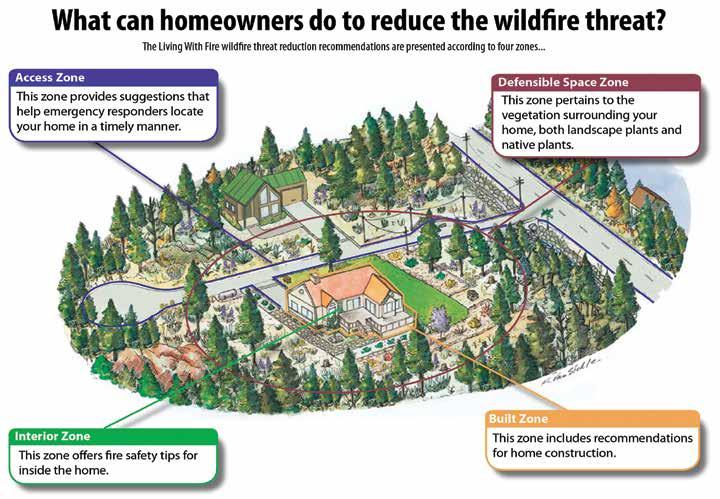
3 minute read
Does your home have defensible space?
Defensible Space Resources
California Cooperative Extension Offices | ucanr.edu
Advertisement
Chipping/mulch programs
| Contact local fire district; livingwithfire.com
Defensible Space Inspection
| Contact local fire district; tahoelivingwithfire.com
Living with Fire homeowner’s guide | trpa.gov
Native plants | naes.agnt.unr.edu
Nevada Cooperative Extension Offices | ucanr.edu
Tree removal | trpa.gov
If a wildfire breaks out, will firefighters be able to save your home? Having defensible space around your home will mean the difference between whether firefighters can save your home or not.
The term defensible space refers to the area between a house and an oncoming wildfire where the vegetation has been managed to reduce the wildfire threat and allow firefighters to safely defend the house. In the event that firefighters are not available, defensible space also improves the likelihood of a home surviving without assistance.
Defensible Space Zone
The size of the defensible space is usually expressed as a distance extending outward from the house in all directions. The recommended distance is not the same for every home. It varies depending on the dominant vegetation surrounding the home and steepness of slope.
Once the recommended distance for defensible space is known, mark it by tying strips of cloth or flagging to shrubs. This becomes the Defensible Space Zone.
If the Defensible Space Zone exceeds your property boundaries, talk to neighbors about creating defensible space and offer to help with the work. It is important to note that the effectiveness of the Defensible Space Zone improves when entire neighborhoods implement defensible space practices.
REMOVE DEAD VEGETATION, DEBRIS
Remove dead and dying vegetation including:
• Dead and dying trees.
• Dead native and ornamental shrubs.
• Dead branches.
• Dried grass, weeds and flowers.
• Exposed branches from fallen trees that are embedded into the ground.
FOR FALLEN PINE NEEDLES & LEAVES
• Within 5 feet of the house, remove routinely throughout fire season.
• From 5 feet to 30 feet of the house, remove every spring.
• More than 30 feet from the house, do not allow fallen needles and leaves to exceed a depth of 3 inches.
Thin Native Vegetation
Within the Defensible Space Zone, native trees and shrubs (Jeffrey pine, white fir and manzanita) should not occur in dense stands. Dense stands of trees and shrubs pose a significant wildfire threat.
Within 30 feet of the house, the canopies of individual or small groups of several trees should be separated by 10 feet to 30 feet. Contact local fire professionals or TRPA to have trees evaluated and marked for removal.
Remove Ladder Fuel
Vegetation that can carry a fire from low-growing plants to taller plants is called ladder fuel. In areas where trees have been thinned as noted above, lower tree branches should be removed to a height of at least 10 feet. Shrubs and trees growing under the drip line should also be removed.
Irrigated, well-maintained lawns and flower beds, as well as low-growing ground covers can be present under the tree’s drip line if it would not allow a fire to ignite the tree. Removal of tree branches should not exceed one third of the total tree height. Removing more than this can be detrimental to tree health. For tips on proper tree pruning, contact a Cooperative Extension office.
LEAN, CLEAN & GREEN AREA
Create a Lean, Clean and Green Area extending 5 to 30 feet from the house. The first goal is to eliminate easily ignitable fuels, or kindling, near the house. This will help prevent embers from starting a fire in a yard. The second goal is to keep fire intensity low if it does ignite near the house.
• Remove dead and drying vegetation and debris regularly.
• Wood and bark mulches can be used in this area, but not in a widespread manner and areas should separated by noncombustible materials.
• Native shrubs should be substantially reduced in this area. Individual specimens or small groups can be retained as long as they are kept healthy and vigorous, pruned and would not allow a fire to travel rapidly across the area.
• Use low-growing (less than 18 inches tall), irrigated, herbaceous plants, such as lawn, clover, erosion-control grasses, flowers, some ground covers and succulents, that are recommended for the area.
• Ornamental, deciduous trees and shrubs can be used as specimens or in small groups. They should be irrigated, kept healthy and vigorous, free of dead leaves and wood, and arranged so that they could not rapidly transmit fire.
• Ornamental evergreen shrubs and trees such as juniper, mugo pine, Austrian pine and others, should not be used within this area.
• Clear all flammable vegetation from within 10 feet of a propane tank.
• Remove tree limbs that are within 10 feet of a chimney, house, deck and roof. Remove limbs that are encroaching on power lines.
Noncombustible Area
Create a Noncombustible Area at least 5 feet wide around the base of the house. It should consist of noncombustible landscape materials and ignition-resistant, low-volume plants.
Maintain Defensible Space Zone
Maintaining a defensible space is an ongoing activity. Plants grow back and flammable vegetation needs to be routinely removed and disposed of properly. | trpa.gov n





